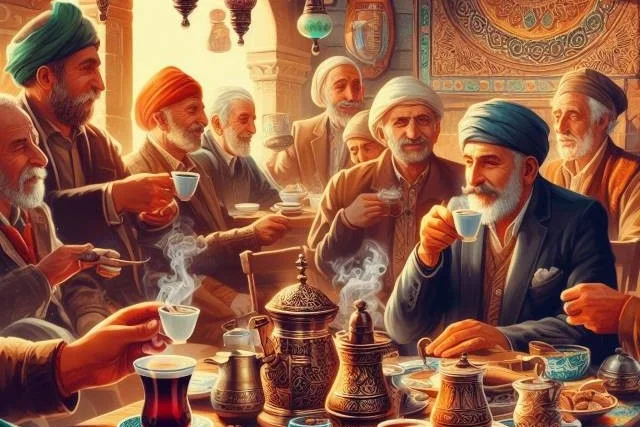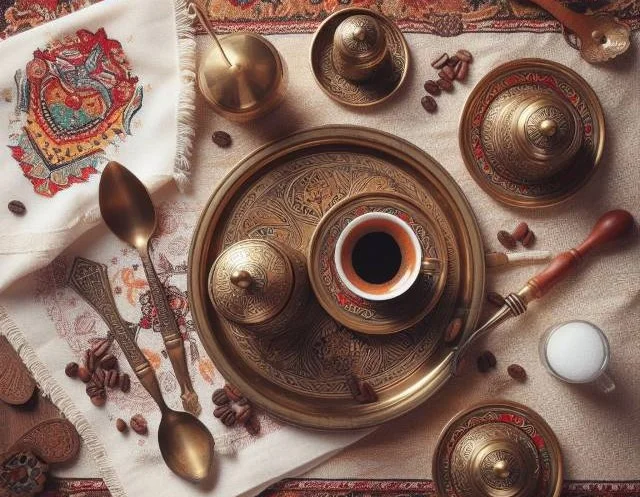Turkish Coffee Traditions
TTurkish coffee traditions have endured for centuries in Turkey and surrounding regions, making it a unique and culturally significant beverage. Its strong, rich flavor and traditional preparation methods offer much more than just a quick caffeine boost. Beyond its delicious taste, Turkish coffee is deeply ingrained in social gatherings and is even associated with fortune-telling rituals, highlighting its importance in a rich cultural tradition.
Key Takeaways
- Cultural Significance: Turkish coffee is deeply woven into Middle Eastern heritage, known for its role in social gatherings and fortune-telling rituals.
- Distinct Brewing: Turkish coffee’s unique preparation involves finely ground beans in a cezve, resulting in a bold, unfiltered flavor profile with a thick crema.
- Cultural Traditions: Turkish coffee is a cultural institution, tied to customs like fortune telling, wedding rituals, and the significance of coffeehouses.
- Health Benefits: Turkish coffee offers health benefits due to its antioxidants and unique preparation, aiding digestion and potentially promoting longevity when consumed moderately.

What is Turkish Coffee?
Turkish coffee, known as Türk kahvesi in Turkey, is a style of coffee prepared by boiling finely ground coffee beans in a pot called a cezve. The beans are ground to a consistency between fine powder and granulated sugar, allowing for maximum extraction of flavor.
The coffee grounds are boiled with water and sometimes sugar, producing a thick, muddy crema on top. It is served in small cups with the grounds settling to the bottom as you drink.
Compared to other brewing methods, Turkish coffee is:
- Much stronger and more bitter, with a mouthfeel thickened by fine grounds
- Brewed with coffee beans ground extra-fine into a powder
- Boiled slowly in a narrow cezve pot instead of filtered
- Served unfiltered with the grounds remaining in the cup
This gives it a uniquely bold, intense taste unlike regular filtered coffee. The ultra-fine grind and lack of filtering allows for robust flavor while also thickening the coffee’s texture.
Why Turkish Coffee Traditions are So Distinct
Turkish coffee stands alone as a unique brew. From the grind to the flavor, it plays by its own rules. One sip and you know this isn’t your average cup of joe.
So what exactly makes Turkish coffee so different?
Brewing Method
The brewing method is unique. Turkish coffee is simmered in a cezve, a little metallic pot. The cezve heats and cools the brew repeatedly, creating foam. This cycle results in a dense yet smooth coffee with muddy texture. Other techniques like pour over and French press don’t produce the same effect.
Grind Size
An extra fine powder-like grind sets Turkish coffee apart. This allows complete extraction and strong flavor. No other coffee uses grounds quite so fine. The tiny particles give it a distinct silky, thick texture. Coarser grinds limit extraction but work for other brews.
Flavor Profile
Sugar balances the inherent bitterness of Turkish coffee. The sweetness offsets the intense taste. Most coffees don’t use sugar due to their milder profile. But Turkish coffee embraces the sweet and bitter combo as part of its appeal.
Cultural Significance
Turkish coffee has deep cultural roots. Elaborate rituals surround preparing and serving it as a sign of hospitality. Fortune telling by reading the grounds is traditional. No other coffee is so ingrained in customs and traditions.
A True Original
With its unique traits from start to finish, Turkish coffee remains in a league of its own. No other coffee can compare when it comes to its powerful flavor, distinct texture, and cultural heritage. It offers an experience every coffee lover should seek out.
Differences from Filtered Coffee
| Turkish Coffee | Filtered Coffee |
| Ultra-fine powder grind | Coarse grind |
| Unfiltered, grounds remaining | Filtered, no grounds |
| Muddy crema on top | No crema |
| Strong, bitter taste | Mild, smooth taste |
| Brewed in cezve pot | Brewed in drip machine |
Turkish coffee has a bolder, grittier taste compared to mellower filtered coffee.
Differences from Espresso
| Turkish Coffee | Espresso |
| Ultra-fine powder grind | Fine grind |
| Strong, bitter taste | Strong, slightly bitter |
| Thin frothy foam | Thick velvety crema |
| Gritty with grounds | No grounds |
| Simmered | Brewed under pressure |
While both are intense, espresso uses pressure and finer grounds for a cleaner, thicker crema, unlike Turkish coffee’s thin foam and grounds.
The Story of Turkish Coffee
Turkish coffee has a long and lively history. This unique brew has origins stretching back over 500 years and continues to play a vital role in Turkish culture today.
So when and how did Turkish coffee first emerge? The timeline below traces key events in its history:
| Year | Event |
| 1450s | The Ottoman Turks are first introduced to coffee, a new drink from Yemen and Ethiopia, as their empire expands. |
| 1555 | The first coffeehouse opens in Istanbul. Coffeehouses become popular gathering spots. |
| 1500s | The cezve, the signature Turkish coffee pot, is invented. This allows Turkish style brewing. |
| 1711 | The Turkish dance the “Kofti” is first described as energizing dancers with coffee between acts. |
| 1783 | The Greek/Turkish classic “briki” coffee pot becomes popular. Similar to the cezve. |
| 1850s | The Turks open Istanbul’s first famous coffeehouses like Cafe Lebon. |
| 1880s | Coffee export begins from Istanbul to Europe. Coffeehouses boom in popularity. |
| 2013 | Turkish coffee culture is registered as Intangible Cultural Heritage. |
| Today | Turkish coffee remains integral to Turkish daily life and hospitality. |
So Turkish coffee emerged in the Ottoman empire centuries ago. The cezve pot and coffeehouses allowed it to flourish as a social institution and cultural beverage.
While invading forces introduced coffee itself from Africa and Yemen, the Turks made it their own by inventing their unique tools, brewing style, and coffee-centric culture. From Turkey, Turkish coffee expanded to Europe through trade and immigration.
Traditional cezve brewing and coffeehouse rituals have endured for generations as an integral part of Turkish culture. Even as coffee trends come and go, Turkish coffee remains a beloved fixture for Turks and those who learned the craft from them.
Sipping the thick, fragrant brew allows one to ponder the rich history in each drop. When you taste Turkish coffee, you are experiencing a legacy hundreds of years in the making and still cherished today around the world.
Cultural Traditions of Turkish Coffee

Turkish coffee is more than just a drink – it is a cultural institution. Elaborate traditions and rituals have developed around Turkish coffee over centuries of cherished history.
Beyond its distinctive preparation and taste, Turkish coffee is set apart by its role in daily life, ceremonies, and hospitality. What are some notable cultural traditions connected to this iconic beverage?
Fortune Telling Tradition
A unique tradition is fortune telling by reading the patterns made by leftover coffee grounds in the cup or saucer. The grounds form shapes and symbols that fortune tellers interpret to predict the future. This practice is rooted in centuries of mysticism and is only done with Turkish coffee.
Wedding Tradition
Serving Turkish coffee is an important wedding ritual. At the celebration, the groom’s family serves Turkish coffee on ornate trays to the bride and guests. It represents hospitality, sweetness, and blessings for the couple.
Coffeehouses
The Turkish coffeehouse is a vital institution. More than a cafe, it is a social and cultural hub. Customs govern behaviors like proper seating arrangements, paying for neighbors’ coffees, and conversing quietly. Coffeehouses facilitate community and connection through coffee.
Gift Giving Customs
It is traditional to give Turkish coffee-themed gifts. Intricately designed cezve pots and tiny coffee cups make meaningful presents for engagements, weddings, holidays, or to show hospitality. The gifts reflect Turkish coffee’s cultural significance.
Culinary Traditions
Turkish coffee is served after meals or business dealings to aid digestion and productivity. It complements Turkish desserts like baklava, lokum, and helva. Coffee’s role in dining exemplifies its broader cultural integration.
Coffee Inspired Dances
Folk dances use moves that mimic preparing and serving Turkish coffee. Dances like “Kofti” act out the ritual through hand gestures portraying heating the cezve or stirring coffee. This further reflects coffee’s embedded place in tradition.
Through many customs, Turkish coffee acts as a social glue bonding friends and family. For Turks, coffee ceremonies embody hospitality, celebration, reflection, and connection to the past. The traditions surrounding it demonstrate coffee’s profound cultural impact.
Brewing Turkish Coffee
Brewing authentic, traditional Turkish coffee is an engaging process that rewards you with a strong, aromatic drink topped with a thick layer of foam.
To achieve the perfect cup, you need to use freshly roasted coffee beans ground superfine into a powdery consistency. This ultra-fine grind is key for fully extracting flavors and producing that signature muddy Turkish coffee texture.
The beans are brewed in a special long-handled pot called a cezve. Designed specifically for Turkish coffee, the cezve allows you to simmer and froth the coffee repeatedly without burning your hand.

Instructions for Brewing Turkish Coffee
- Grind beans to an ultra-fine powder using a Turkish or specialty coffee grinder
- Add 2-3 heaping teaspoons of finely ground coffee per 3-4 oz serving to the cezve. Include up to 2 tsp sugar if desired.
- Pour cool, fresh water into the cezve, around 3-4 oz per serving. Stir gently to dissolve grounds.
- Heat cezve over medium heat until it just begins to boil. Remove from heat.
- Return cezve to heat, letting coffee rise almost to a boil 2-3 more times to froth up.
- Pour a small amount of coffee into each cup, then back into cezve to evenly distribute foam.
- Holding back grounds, gently pour coffee into cups and serve immediately.
The most critical first step is grinding the beans. You need a consistency like powdered sugar. This allows the hot water to extract the most flavor and aroma compounds possible. Pre-ground coffee won’t cut it for authentic Turkish coffee.
Heating the cezve slowly and frothing repeatedly creates that foamy layer or “kaimaki” that tops great Turkish coffee. Letting it rise several times without boiling over takes practice. Have a spoon nearby to stir and watch closely.
When pouring, distribute the foam evenly among cups. Pour gently and stop when you see grounds start to trickle out. Serve promptly so guests can enjoy Turkish coffee at the peak of taste and temperature.
With attention and care, you can create the perfect brew of Turkish coffee right at home. Mastering the technique allows you to share the enduring Turkish ritual with family and friends.
The Meaning Behind the Foam
A signature feature of Turkish coffee is the rich, mousse-like foam floating on top. For Turks, this foam carries deep cultural meaning and symbolism.
So what exactly does this delicate froth represent?
| Type | Meaning |
| Brewing Foam | Created by proper technique |
| Serving Foam | Shared among cups and guests |
| Fortune Foam | Grounds patterns are “read” after |
| Celebration Foam | Signifies weddings, holidays, cheer |
| Poetry Foam | Inspires lyrical metaphors |
Brewing Foam
The foam comes from the brewing process. Coffee grounds are repeatedly heated, cooled, and frothed in a long-handled cezve pot. Doing this cycle skillfully produces the desired layer of foam. So its presence demonstrates the brewer’s knowledge and care.
Serving Foam
Before serving Turkish coffee, the host pours some into each cup, then back into the cezve. This evenly distributes the treasured foam among guests. Sharing it shows hospitality.
Fortune Foam
Traditionally, fortune tellers inspect the foam’s unique patterns to predict the future. The shapes and marks left after drinking are “read” like tea leaves. This folk custom relies specifically on Turkish coffee foam.
Celebration Foam
At weddings and holidays, foam represents joy, prosperity, and fertility for occasions like marriages. Its presence signals celebration and good fortune.
Poetry Foam
Turkish poets have been inspired by the foam’s visual metaphors for centuries. They liken its swirling shapes and transience to romance, passion, and the divine.
Beyond the technical aspects, foam also represents hospitality, happiness, spirituality, and creativity. Turkish culture values this ephemeral crown for its many layers of meaning.
To Turks, foam symbolizes far more than just a texture or ingredient. Masterfully coaxing out this fragrant topping demonstrates great cultural fluency and care. Appreciating its significance offers insight into traditions around this distinctive brew.
So savoring the multidimensional foam atop Turkish coffee provides a richer experience. Tasting tradition, celebration, poetry, and connection in the frothy bubbles gives greater meaning to each sip.
The Healthful Aspects of Turkish Coffee

With its high antioxidant content and unique preparation, Turkish coffee offers surprising health benefits alongside its rich flavor.
What are some of the ways this iconic brew can be good for you?
| Benefit | Description |
| Antioxidants | Natural compounds that counter aging and disease |
| Chlorogenic acids | Potent antioxidants abundant in coffee beans |
| Cafestol and kahweol | Unique oily antioxidants only extracted via boiling |
| Better digestion | Can aid digestion and gut health |
| Liver protection | Shows protective effects on the liver |
| Longevity | Associated with living longer in some populations |
| Hydration | Provides fluids and electrolytes |
| Metabolism | May boost metabolism and fat burning |
The natural chlorogenic acids in coffee deliver powerful antioxidant effects. And the fine grinding and boil-brewing extract special oily antioxidants like cafestol and kahweol that you won’t find in filtered and cold coffees.
The bioactive compounds in Turkish coffee may also benefit digestion, with prebiotic and probiotic effects on gut bacteria. The drink could also help protect the liver against damage according to some studies.
Research shows coffee drinkers tend to have lower risks of diseases like diabetes, dementia, and stroke. So for some populations, regular coffee consumption is associated with longevity.
Of course, coffee also provides hydration and essential electrolytes. And its caffeine may aid metabolism, fat burning, and exercise performance when consumed in moderation.
So sipping this antioxidant-rich brew provides more than just a burst of energy. The unique preparation offers distinct health benefits for the body and mind.
The Range of Turkish Coffee Types
While known for its signature bold brew, Turkish coffee actually encompasses numerous delicious regional variations. What are some different types to try?
Notable Turkish Coffee Types
- Sade: Plain Turkish coffee with sugar – Sade represents the standard style – Turkish coffee boiled with water and sugar. A pure, straightforward preparation.
- Mena: Spiced with cardamom, cinnamon, cloves – Mena incorporates warming spices like cardamom, cinnamon, and cloves. This adds aromatic depth and complexity.
- Essaouira: Features butter and salt instead of sugar – Essaouira is prepared with butter and salt instead of sugar, popular in parts of the Middle East. It imparts a rich, smooth taste.
- Dibrik: Served with dried fruit skins and shells – Dibrik is historically served with fruit skins and shells to infuse fruity, herbal notes. Aleppo features savory spices like ginger and black pepper.
- Aleppo: Uses ginger, black pepper, and spices
- Ristretto: Bolder and thicker due to shorter brew time – Ristretto uses a quicker brew time to produce an extra strong, concentrated cup. Iced Turkish coffee is served over ice to chill and dilute the hot-brewed coffee.
- Iced: Hot brewed then cooled over ice
Far beyond just one style, Turkish coffee contains multitudes. The array of regional recipes opens up new dimensions of flavor while remaining true to its cultural roots.
Savoring the classics alongside bold new variations creates appreciation for both the familiarity and uniqueness embodied in this storied brew.
Best Ways to Enjoy Turkish Coffee
When drinking Turkish coffee, there are some traditions and customs to follow for full appreciation:
- Drink from small ceramic fincan cups – These thimble-sized cups suit the concentrated brew and keep it hot.
- Add sugar sparingly to balance bitterness – Sugar complements but shouldn’t overpower the inherent coffee taste.
- Inhale the aromas first before sipping – Prepare your senses by capturing the fragrant scent.
- Drink while hot to enjoy the coffee and foam – Heat keeps the flavors and textures optimized.
- Drink within 5 minutes of brewing for freshness – The taste declines quickly as coffee cools.
- Pair with Turkish desserts like baklava or lokum – Complimentary sweet flavors enhance the experience.
- Savor slowly while relaxing and conversing – The ritual is social and contemplative.
Following these simple traditions allows for deeper sensory and cultural appreciation. The customs complement the distinctive sensory experience of Turkish coffee.
Each deliberate step engages another sense, adding layers of meaning and connection. So prepare and sip Turkish coffee mindfully to unlock its rich heritage in every drop. Let the tastes and aromas transport you through time and place.
Turkish Coffee Culture Lives On
For over 500 years, Turkish coffee has been an integral part of culture, community, and health in Turkey and beyond. From the intricate preparation to rituals like fortune telling, it represents hospitality, friendship, and leisure.
Though Western coffee chains have spread, traditional kahvehanelers (coffeehouses) persist in Istanbul and Turkish coffee remains popular, especially among younger generations.
Each cup of Turkish coffee enjoyed continues strengthening the enduring social bonds and deep cultural heritage.








